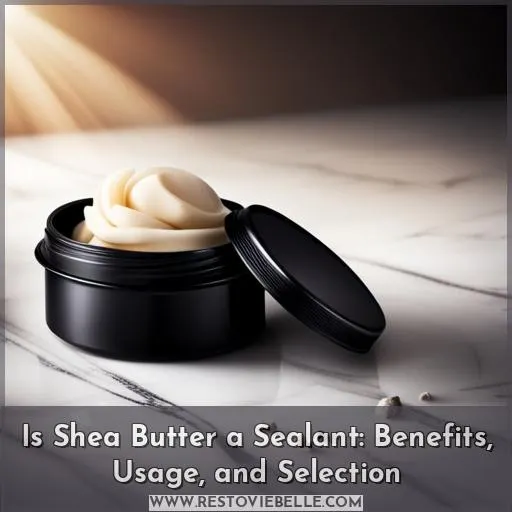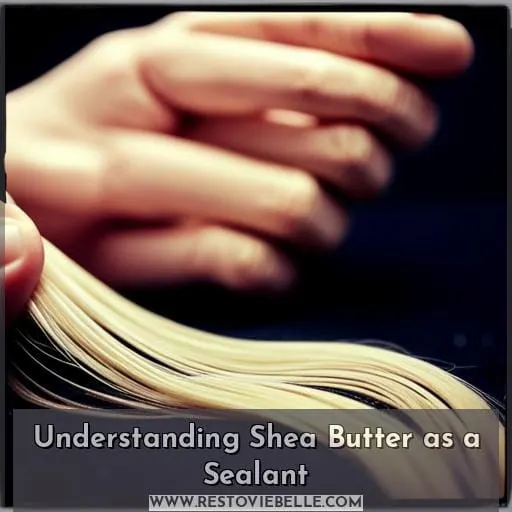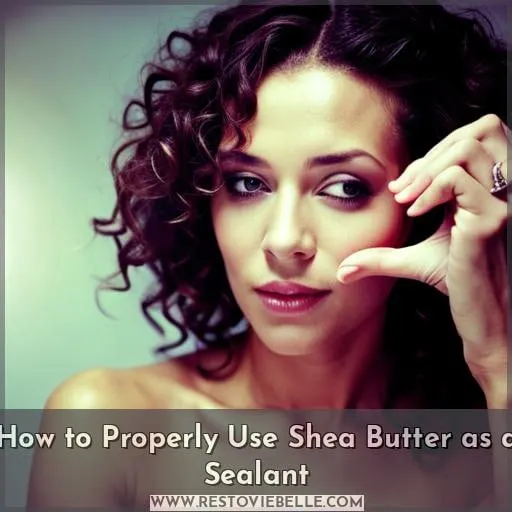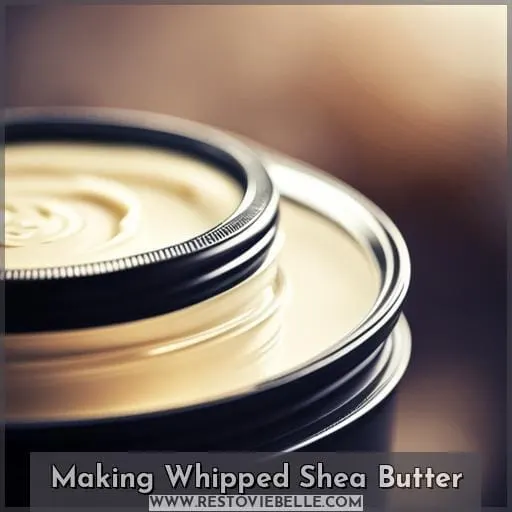This site is supported by our readers. We may earn a commission, at no cost to you, if you purchase through links.
 Jump-starting your hair care journey can be daunting, with all the products and techniques available—which is why shea butter has been a go-to for generations. A star ingredient in many natural beauty treatments, it’s no surprise that its use as a sealant has sparked controversy.
Jump-starting your hair care journey can be daunting, with all the products and techniques available—which is why shea butter has been a go-to for generations. A star ingredient in many natural beauty treatments, it’s no surprise that its use as a sealant has sparked controversy.
We’ll explore this question by looking at the benefits of using it as a sealant, how to select the right product for you, and how to properly apply it for maximum results.
This ultimate guide will help unlock the power of one of nature’s most versatile ingredients: unrefined shea butter! With its deep nourishing properties and ability to protect against UV rays while soothing skin irritations like eczema—it’s no wonder why so many are turning towards this ancient remedy as their go-to solution when sealing in moisture!
Table Of Contents
Key Takeaways
- Shea butter serves as a sealant, not as a moisturizer.
- It locks in moisture and retains hydration in natural hair.
- Combine it with water-based products for the best results.
- Natural oils like coconut oil enhance its sealing properties.
Understanding Shea Butter as a Sealant
Are you unsure about shea butter’s role in hair care? There is a debate among many about whether it functions as a moisturizer or sealant. Though its lack of water content may lead some to believe it acts as the former, shea butter truly serves better as the latter.
Role of Shea Butter in Hair Care
Discover how to use Shea Butter in your hair care routine for maximum benefits! The shea butter debate has been ongoing – is it a moisturizer or a sealant? It’s important to understand its role when using it for natural hair care.
Unrefined, 100% shea butter offers the most nutrients and can be used below the neck if you have oily skin or hair. It acts as an occlusive agent, locking moisture into strands after applying water-based products.
To soften it, steam instead of microwaving – this preserves essential vitamins and minerals – then store in an airtight container.
Use it as the final step in your regimen; the results will be softness and hydration like no other!
Debate Over Moisturizer Vs. Sealant
You may have heard the debate over whether shea butter is a moisturizer or sealant, but it’s time to settle this once and for all! Shea butter helps retain moisture in natural hair, making it an ideal sealant.
Application techniques should be followed correctly for optimal results: spritz with water at night before applying shea butter on wet hair and use unrefined products below the neck.
Natural oils such as coconut oil can also help enhance its sealing properties – creating soft, hydrated locks! Remember that while shea butter is not a true moisturizer; when used properly alongside one it will provide maximum benefits for your curls.
Lack of Water Content in Shea Butter
Despite its many benefits, shea butter lacks water content – a key element for true moisturizing – making it more suitable as a sealant. When using it on natural hair, apply it after applying a water-based product first to prevent dryness and damage.
Application techniques should be tailored to the individual’s hair texture and desired results.
Benefits of Using Shea Butter as a Sealant
You’re probably familiar with shea butter, but do you know the myriad of benefits it provides? Not only is this timeless beauty ingredient from Africa known to moisturize and soften dry skin, its healing and soothing effects can reduce inflammation while offering some UV protection.
Moisturizing Properties
Diving deeper, you’ll find that shea butter has a unique blend of vitamins C and E, offering a variety of moisturizing properties. These properties help keep your hair soft and protected from the elements. When applied as a sealant on natural hair, shea butter’s oil-like texture helps retain moisture.
For optimal results, it’s best to use it after applying water-based moisturizers as part of regular hydration techniques. To maximize the effects, you can add in some natural oils or other products like Donna Marie before sealing in with shea butter.
Shea butter is also safe to use below the neck if desired. It provides all-over nourishment when stored properly in an airtight container away from direct heat sources, such as microwaves, which may damage its nutrients.
Healing and Soothing Effects
Experience the healing and soothing effects of shea butter when you use it as a sealant on natural hair. Shea butter is rich in vitamins C and E, which help protect your skin from UV damage while moisturizing dry areas.
It has anti-inflammatory properties to reduce scalp irritation, plus emollient qualities that soften and soothe skin inflammation.
UV Protection
You can benefit from the UV protection properties of shea butter, with its natural vitamins C and E providing a welcome shield for your hair. Shea butter, derived from Vitellaria paradoxa, helps protect your hair against breakage caused by environmental stressors like sun damage.
Here are some benefits to using shea butter:
- It has high levels of vitamin C, which helps repair damaged follicles.
- Vitamin E acts as an antioxidant to stop free radical damage.
- Shea butter contains natural anti-inflammatory agents that soothe dry or itchy scalp.
To maximize the benefits, it is important to select quality products. Opt for 100% pure, unrefined shea butter if possible. Whipped forms are easier to apply and offer nourishing sealants without clogging pores.
For best results, apply shea butter after water-based moisturizers. Remember to store it in airtight containers at room temperature to maintain its effectiveness.
Versatility in Various Products
Take a journey through the many uses of shea butter, from face cleansers to lip balms and shampoos – unlocking its versatile potential as an efficient sealant. Shea butter is widely used in cosmetics, skincare, and haircare for moisturizing and healing purposes.
It can also be found in cooking recipes or traditional medicine practices, such as relieving muscle aches with shea oil massage.
Whipped shea butter, mixed with essential oils, helps combat split ends while providing much-needed moisture retention to hair follicles when applied at night before bedtime.
Selecting the Right Shea Butter Products
When it comes to using shea butter for your natural hair, selecting the right product is essential. Unrefined shea butter provides the most benefits since it contains all of its natural oils and vitamins.
Importance of Unrefined Shea Butter
For the best results, opt for unrefined shea butter to seal in moisture and protect your hair from damage. It contains vitamins C and E that offer UV protection and soothe skin inflammation or irritation.
With its moisturizing and healing properties, it melts into oil when applied or heated, making it ideal for use below the neck if you have oily skin or hair. Shea butter has timeless beauty benefits as a sealant with nourishing oil-based properties that soften dryness without losing moisture.
Plus, with its online purchase convenience, potential savings are available too! For optimal results, apply after a water-based moisturizer, then store in an airtight container—you’ll be glad you did!
Identifying Pure Shea Butter on Labels
Be sure to look for Butyrospermum parkii, the scientific name of shea butter, on labels when selecting a pure product.
Online shopping can offer convenience and savings while ensuring nutrient preservation by softening using steam instead of a microwave.
If you have oily skin or hair, use shea butter below the neck as it provides protection from UV rays and soothes inflammation due to its vitamins C & E content.
Shea Butter’s role in hair care is essential for sealing in moisture, but it should not be used as a moisturizer itself.
Considerations for Oily Skin or Hair
If you have oily skin or hair, it’s best to use shea butter products below the neck. Refined, 100% shea butter is the purest form; look for Butyrospermum parkii on labels. Application should follow a water-based moisturizer and be done with spritzed wet hair at night.
A whipped product with natural oils makes an excellent sealant, which can be softened using steam rather than microwaves to preserve nutrients.
How to Properly Use Shea Butter as a Sealant
Are you wondering if shea butter is a sealant? Understanding how to properly use it as one can help maximize its benefits for natural hair care and ensure your locks stay hydrated and healthy. In this article, we’ll discuss the best practices when using shea butter as a hair sealant.
Recommended Brands for Moisturizers
Choosing the right moisturizer for your natural hair is key, so shop around and don’t settle for just any brand – a bad workman blames his tools!
Shea Butter Benefits include softening dry skin and preventing moisture loss. Popular brands like Shea Moisture are known to provide quality products designed specifically for natural hair care.
For Hair Sealant Selection, try unrefined shea butter or whipped with oils to nourish without buildup of grease on the scalp. Recommended brands include Donna Marie Products from Good Hair Mart as well as other online stores offering convenience and potential savings when replenishing supplies of top-rated moisturizers.
Nighttime Routine for Hydrated Hair
To maximize hydration, incorporate a nighttime routine with shea butter as the sealing agent. Spritz thin hair with water and apply a light layer of shea butter to seal in the humectant.
Utilizing this method will help keep locks healthy and vibrant while preventing moisture loss during sleep hours.
To get truly nourished strands come morning, try adding natural oils like coconut oil or almond oil into your whipped shea butter mixture before application at night.
Differences Between Refined and Unrefined Shea Butter
Discovering the distinctions between refined and unrefined shea butter can be a daunting task, yet it’s worth taking the time to explore an ocean of possibilities for your hair.
Unrefined shea butter is generally available in beauty supply stores or online retailers like Shea Moisture. It boasts more natural benefits than its counterpart, providing vitamins C and E as well as UV protection.
Refined shea butter has been processed with heat or chemicals. While still offering moisturizing properties, some of its nutrients are lost in this process, making unrefined a better choice for most applications on natural hair.
Knowing what type to choose when shopping helps ensure you get all the nourishing benefits that come from utilizing this timeless beauty ingredient!
Making Whipped Shea Butter
Creating a nourishing whipped shea butter for your natural hair is easy with the correct technique. Softening shea butter using steam instead of a microwave ensures that its nutrients are preserved and maximizes its benefits as an effective sealant.
Softening Shea Butter With Steam
For best results, steam shea butter to soften it and preserve its nourishing properties. To do this DIY method, heat a pot of water until there’s enough steam rising from it. Then place the unrefined shea butter in a bowl over the steaming hot water for 10 minutes or so before stirring with an implement like a spoon or whisk until a smooth texture forms.
This ancient West African beauty ingredient can then be used as part of your natural hair application routine. Follow up with another water-based product, such as conditioner, for optimal sealant effect on strands without sacrificing nutrient preservation thanks to this softened whipped form.
Shop online for convenient access to quality products that deliver the desired end results!
Avoiding Microwaves for Nutrient Preservation
Instead of microwaving your shea butter to soften it, opt for a more nutrient-preserving method like steam. Steam softening preserves the vitamins and other beneficial ingredients found in unrefined shea butter.
When soft, store it in an airtight container away from heat and moisture to maintain its consistency.
Don’t forget that whipped shea butter with natural oils is a nourishing hair sealant. Just make sure you keep it stored safely so its effectiveness isn’t compromised by outside elements.
Get the most out of your investment while keeping nutrients intact by using steam instead of microwave alternatives when softening shea butter!
Proper Storage of Whipped Shea Butter
To ensure optimal results, store your whipped shea butter in an airtight container. This will help preserve the nutrients and maintain its moisture-sealing properties.
When it comes to proper techniques for using shea butter on natural hair, storage is key! Keep containers sealed tight. Not only does this prevent contamination, but it also helps lock in those beneficial vitamins and minerals that make this product so great.
Be sure to check expiration dates as well. While unrefined shea butter can last a long time when stored correctly, don’t take any chances with old or expired products – toss them out and stock up on fresh stuff!
For best results, use quality ingredients like 100% pure unrefined Shea Butter packed full of nourishing oils from Good Hair Mart.
Conclusion
Finally, it can be ascertained that shea butter is indeed a sealant, not a moisturizer. When used correctly, it offers fantastic benefits, including moisturizing, healing, soothing, and UV protection. To ensure optimal results, it is important to select the right products; unrefined, 100% shea butter is the purest form.
The best way to use shea butter as a sealant is to apply it after a water-based moisturizer and make sure to soften it with steam, not in a microwave. With these simple tips, you can enjoy the full range of the advantages that shea butter offers.











